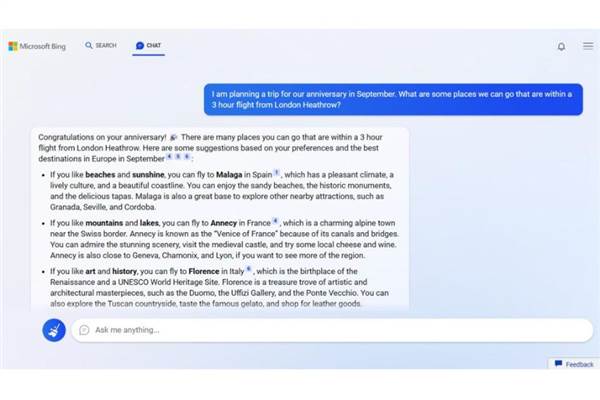
Microsoft has launched its eagerly anticipated ChatGPT-powered Bing search engine and Edge browser that aims to deliver better search results and more complete answers.
The search engine and browser have been combined into one unified experience, with a chat feature that allows users to refine their search and receive answers to more complex questions.
The new Bing and Edge has been developed with the latest technical advancements in AI, including OpenAI large language model and Microsoft's Prometheus model, which Microsoft says will lead to improved search relevance.
The launch of the new Bing and Edge comes as just yesterday, Google launched its new AI-powered search engine, Bard. This increased competition in the AI-powered search engine market highlights the growing importance of AI in providing more accurate and relevant results to users.
"AI will fundamentally change every software category, starting with the largest category of all – search. Today, we’re launching Bing and Edge powered by AI co-pilot and chat, to help people get more from search and the web,” said Satya Nadella, chairman and chief executive officer of Microsoft.
Paul Meinshausen, co-founder of Aampe, explains with Google’s Bard and the ChatGPT-powered Bing search engine, experience and technology of search is clearly going to change and it will be an exciting time.
He points out Google's natural advantages are being able to manage the scale of the web to handle keeping AI more real-time and updated with the latest information and facts, for example. In addition, a large part of the global population turns to Google for information and search by default.
"OpenAI showed how rapidly a newer brand can grow - getting to I believe 100 million users already, but that's still a fraction of Google and retention will still be a hard problem. Watch out for how AI is going to show up in non-search applications,” Meinshausen tells Campaign Asia-Pacific.
For example, he notes Google and Microsoft’s suite of applications are all massive in themselves like Outlook, Office, Google Docs, Google Sheets, Maps, Photos, YouTube, and others. Take Google Docs as an example, with an AI assistant built right into the interface.
"For Google Photos, people are generating all kinds of art using the various generative AI applications: What if you could have AI learn over the last 15-years of personal and family photos you have in your photos account, and then "fill in the gaps" in experiences or even "generate" "memories" of events that never happened?” asks Meinshausen.
(This article first appeared on CampaignAsia.com)








.jpg&h=334&w=500&q=100&v=20170226&c=1)













